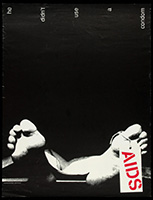
Take 8,000 posters from 130 countries and in 76 languages ranging from shockingly graphic, instructional and scary to tender and compassionate, and select a sampling for an exhibit. The late Edward C. Atwater, a former Batavia resident, physician and medical historian, donated the massive 30-year collection to the University of Rochester in 2007.
Donated to the University by Dr. Atwater in 2007 and housed in the Department of Rare Books, Special Collections, and Preservation, River Campus Libraries, the collection is one of the largest of its kind in the world, said Jessica Lacher-Feldman, whose related roles are co-editor of the book and curator of AIDS Education Posters Collection.
“I actually had a different role when I came, but I have literally been working on this project since I arrived. One of the first things that I did after coming here was going with our then dean to Ruth and Edward Atwater's home to meet them,” she said. “It’s actually very interesting, he was not an immunologist, he was not anybody who focused on HIV AIDS as a medical doctor. And what he discovered, in being a very curious-minded human being, led him in a lot of different directions.”
The collection became a six-plus years project as staff from the University of Rochester and Memorial Art Gallery chronicled it in a book and orchestrated an exhibit, Up Against the Wall: Art, Activism, and the AIDS Poster. Promising 165 of “the most visually arresting and thought-provoking posters,” it runs through June 19 at Memorial Art Gallery in Rochester and is the first major exhibition devoted to the University of Rochester’s vast collection of HIV/AIDS-related posters.
“The oldest poster is from 1982, which is really at the dawn of the crisis before, really before AIDS was really widely understood or named before the 1986 Surgeon General's report that actually spelled things out,” Lacher-Feldman said during an interview with The Batavian. “I work with the collection all the time, and I'm continuously amazed by the messages that are used in the posters and the different tactics that have been deployed in order to get that information out there. It really feels like a by-any-means-necessary thing.”
How it all began ...
Ever since she began at U of R in 2016, Lacher-Feldman, who holds many titles including rare books editor, and exhibits and special projects manager, has immersed herself into the posters, the project and the man who amassed a special history of the who, what and where of HIV and AIDS. Dr. Edward C. Atwater was a physician and medical historian as well as an avid collector of medical artifacts.
Those in the Atwater circle know the tale well of how he spotted the first collection piece while on a subway car; it was a poster promoting AIDS prevention. At a time when sex and conception weren’t even widely discussed in public, he was awestruck by how the topic was depicted on a wall hanging in such a public venue.
His interest grew from there, and Atwater scoured various sources, wrote to or visited health departments and related officials, and requested copies of their AIDS awareness materials. From 1991 to 2019, the year he died, Atwater’s collection went from one to 8,000 pieces. One of them is from Canada, done in several different languages, and others are from Russia, China, Saudi Arabia and Bahrain. Lachman-Feldman had just been editing a poster translated into Moroccan, she said.
”And we've done a ton of really interesting projects with the classes, that you can actually talk with them in so many other different disciplines, including working with medical students or medical humanities classes, but also linguistics and foreign language, translation, anthropology … and graphic design,” she said. “It's amazing how incredibly multifaceted they are.”
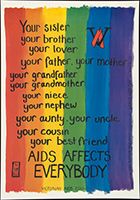
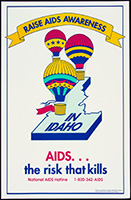
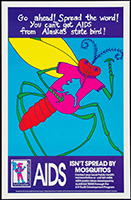
Show organizers said that the posters inspire people to protect themselves, protect others, and change their own behaviors through a broad range of creative expression. The posters widely range in content, she said, from those geared toward night clubs and bars to others for prisons by instructing corrections officers how to search a prison cell and avoid contact with possible sharps. Spanning from 1982 to present day, the materials show how social, religious, civic, activist, and medical organizations have addressed this controversial subject in all ways, from mild to aggressive.
“Sometimes there is a need for shock value. But there's an intentionality in every single poster. They're demonstrating how to do something or not do something, or, you know, trying to evoke something emotional or sentimental or instructive, or whatever it happens to be,” Lacher-Feldman said. “And I think the biggest takeaway for me also is that hammering home the notion that it affects everyone, and it's often seen in the United States as a, quote, gay disease.”
“We've lost a lot of people, and a lot of incredibly talented people very, very young. There's a lot that's very treatable in the United States, and we're seeing a lot of progress in other parts of the world,” Lacher-Feldman said. “So it's important to know that and remember it, and that this is recent history.”
Some of the celebrities who died from AIDS and demonstrated that it attacks all social circles include Rock Hudson, Freddy Mercury, Arthur Ashe, Liberace, Gia Carangi, Perry Ellis, Halston and Eazy-E.
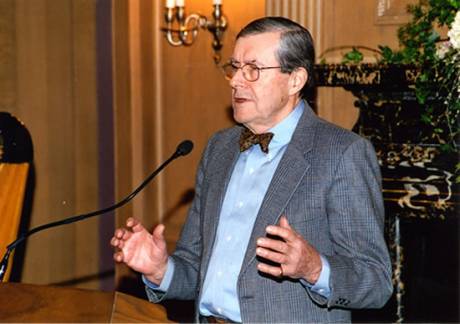
The doctor ...
Edward Congdon Atwater grew up in Batavia, attended Batavia Public Schools, followed by boarding school at Ridley College in St. Catharines, Ontario. During World War II, he served in Europe as a combat infantryman in the Third Army, 101st Infantry. In 1950, the history major graduated from the University of Rochester. During his fifth year, he fulfilled the requirements for medical school, and in 1955, he received a medical doctorate from Harvard Medical School. He served as an intern, assistant resident, and chief resident in medicine at Strong Memorial Hospital. He eventually became an associate professor of medicine and of the history of medicine, teaching medical students and residents and practicing internal medicine, specializing in rheumatology. In the early 1970s, he had a sabbatical year at the Institute for the History of Medicine at Johns Hopkins.
Atwater was author of a number of papers, both in clinical medicine and in the history of medicine, and belonged to several professional medical, historical, and community organizations. Locally, he served on the board of the Landmark Society, plus several other boards including the Friends of the University of Rochester Libraries, the Rochester Academy of Medicine, the Harvard Medical Alumni Association and the American Association of the History of Medicine.
The historian and collector ...
Lacher-Feldman met the Atwater couple and continued working with Dr. Atwater after Ruth died in 2017. Over time she grew to know him as so very “curious, smart and engaged."
“The last time I saw him, I went to palliative care at Strong, and he died within the next day, later that day, so I was very close to him and worked with him really closely. He would say that what he witnessed there was social history and a show of a major shift in the way that information about sexually transmitted diseases, and protection in a very intimate way, was being shared with the world. That crisis, that's what drew him to begin collecting these posters.”
She saw in him a deep commitment to document the issue, and how its prominence shifted, for posterity. And that's what he did, she said. Far from over, the collection will continue to grow and be used for educational purposes, she said. There are QR codes in the gallery for posters with “deep captions” from others sharing their own thoughts and stories. Once the exhibit reaches its deadline in June, the plan is to take it on the road to share with other locales.
“And the fact that we've actually digitized every single poster and made them available, searchable online, has made it really accessible. And that was something that Dr. Atwater wanted to make sure that we did. And we committed to doing that, as part of the agreement for accepting the gift,” she said. “So now, people all over the world can view them, compare them, think about and reflect on how the AIDS crisis has been addressed in different cultures and in different means, and how different messages resonate with different populations.”
Organized by New York-based curator and historian Donald Albrecht, Up Against the Wall will fill Memorial Art Gallery's 5,000- square-foot Docent Gallery and explore the messages and methods used to educate, inform, and provoke audiences worldwide, organizers said.
Hours are 11 a.m. to 5 p.m. Wednesdays through Sundays, 11 a.m. to 9 p.m. Thursdays and select Fridays. Admission is $20; $17 for senior citizens, $11 college students with ID and children 6 to 18; free to members, University of Rochester faculty/staff and students, children 5 and under.
For more information, call (585) 276-8900 or visit mag.rochester.edu
Photos/images from the University of Rochester
